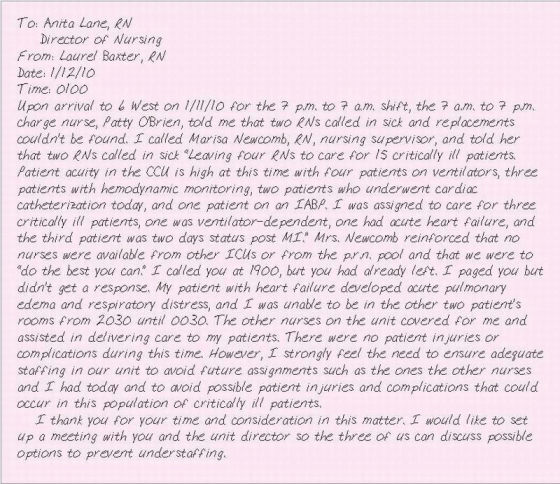U
UNDERSTAFFING
Understaffing occurs when the facility administration fails to provide enough professionally trained personnel to meet the patient population’s needs. Determining whether your unit has too few nurses or too few specially trained nurses may be difficult. The few guidelines that exist vary from state to state and are limited to specialty care units. The Joint Commission’s staffing standard sets no specific nurse-patient ratios. It states generally that the organization should provide an adequate number of staff whose qualifications are commensurate with defined job responsibilities and applicable licensure, laws and regulations, and certification.
If you find yourself assigned to more patients than you can reasonably care for or feel your unit is too understaffed to provide safe care, notify your nursing supervisor immediately. Be specific. Identify the type and amount of staff members you need. If the nursing supervisor can’t or won’t supply relief, notify the administration. If it doesn’t offer a solution, write a memorandum detailing exactly what you did and said and what response you received. Don’t walk off the job (you could be held liable for abandonment); instead, do the best you can.
Filing a written report isn’t guaranteed to absolve you from liability if a patient is injured during your shift. You may still be found liable, especially if you could have foreseen and prevented the patient’s injury; however, a written report will impress a jury as a sincere attempt to protect your patients. The report could also provide you with a defense if the
alleged malpractice involves something you should have done but didn’t because of understaffing. (See Court rulings related to understaffing.)
alleged malpractice involves something you should have done but didn’t because of understaffing. (See Court rulings related to understaffing.)
 LEGAL CASEBOOK COURT RULINGS RELATED TO UNDERSTAFFING
LEGAL CASEBOOK COURT RULINGS RELATED TO UNDERSTAFFINGIn the absence of well-defined staffing guidelines, the courts have had no reliable standard for ruling on cases of alleged understaffing. Each case has been decided on an individual basis.
The decision in the landmark case Darling v. Charleston Community Memorial Hospital (1965) was based partly on the issue of understaffing. A young man broke his leg while playing football and was taken to Charleston’s emergency department where the on-call doctor set and cast his leg. The patient began to complain of pain almost immediately. Later, his toes grew swollen and dark, then cold and insensitive, and a stench pervaded his room. Nurses, who checked the leg only a few times per day, failed to report its worsening condition. When the cast was removed 3 days later, the necrotic condition of the leg was apparent. After making several surgical attempts to save the leg, the surgeon had to amputate below the knee.
After an out-of-court settlement with the doctor who applied the cast, the court found the hospital liable for failing to have enough specially trained nurses available at all times to recognize the patient’s serious condition and alert the medical staff.
Since the Darling case, several similar cases have been tried — for example, Cline v. Lun (1973), Sanchez v. Bay General Hospital (1981), and Harrell v. Louis Smith Memorial Hospital (1990). Almost every case involved a nurse who failed to continuously monitor her patient’s condition — especially his vital signs — and to report significant changes to the attending doctor. In each case the courts have emphasized the:
need for sufficient numbers of nurses to continuously monitor a patient’s condition
need for nurses who are specially trained to recognize signs and symptoms that require a doctor’s immediate intervention.
ESSENTIAL DOCUMENTATION
Take notes during your shift and write a memorandum as soon as possible after your shift is over. Never document a staffing issue in the patient’s chart. Record the name of the nursing supervisor with whom you spoke, the time of the conversation, exactly what you told the nursing supervisor, and her response. Include the names of other administrators you notified, the times they were notified, and their responses. Record any significant events that happened during the shift, noting a lack of care because of understaffing. Keep a copy of the memorandum for yourself, and send the original to the director of nursing.
|
Stay updated, free articles. Join our Telegram channel

Full access? Get Clinical Tree



